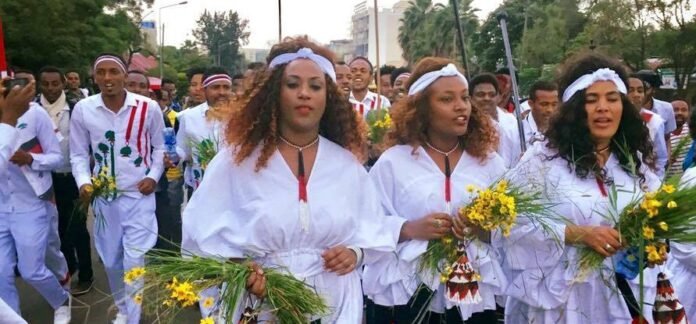Source: Africa Publicity
Irreecha is one of the most important cultural and spiritual celebrations for the Oromo people, an ethnic group that primarily inhabits Ethiopia and parts of Kenya. This festival, which marks the end of the rainy season and the beginning of the harvest, is celebrated with great joy, color, and reverence. It holds deep cultural and communal significance, not only for the Oromo people but also for the broader society in the Horn of Africa. Rooted in ancient traditions and indigenous beliefs, Irreecha symbolizes gratitude, renewal, and unity, highlighting the Oromo people’s connection to nature, spirituality, and community.
Historical and Spiritual Roots of Irreecha
The origins of Irreecha date back centuries, tracing its roots to the pre-Christian, pre-Islamic beliefs of the Oromo people. It is primarily a thanksgiving festival dedicated to Waaqa (God), a supreme deity in Oromo religion, for the blessings of rain, fertility, and good harvests. The Oromo people believe that by observing rituals and paying respects to Waaqa, they can maintain a harmonious relationship with nature and ensure continued prosperity. The timing of Irreecha is symbolic, marking the end of the rainy season when the land is most fertile, and the beginning of the dry season when the harvest is ready to be gathered.
The spiritual aspect of the festival is particularly evident in the offerings made to Waaqa. Oromo people gather in large numbers near bodies of water, such as rivers, lakes, and springs, to give thanks for the blessings received throughout the year. The act of casting flowers, herbs, and other symbolic items into the water signifies a prayer for future abundance, peace, and health. These rituals help maintain a deep sense of reverence for nature and reflect the Oromo’s worldview, which sees humans as an integral part of the natural world rather than separate from it.
Cultural Significance: Unity and Identity
Irreecha also serves as a vital expression of Oromo cultural identity. It is a moment for the Oromo people to come together and celebrate their heritage, language, traditions, and values. The festival is marked by vibrant songs, dances, and communal feasts, where people from all walks of life gather to celebrate their shared history and cultural pride.
The festival is a unifying force within the Oromo community, transcending geographical, social, and political divisions. Traditionally, the Oromo people live in rural areas, but during Irreecha, individuals travel from different regions to come together in one place. This communal gathering fosters a sense of solidarity, reaffirming the bond that ties the Oromo people together, regardless of their diverse backgrounds or locations. It is a time for elders, youth, men, and women to come together in harmony, reinforcing cultural continuity and mutual respect.
The symbolic rituals during the festival emphasize the values of unity, peace, and respect for the environment. One of the most notable practices is the ritual of wearing traditional clothing, such as the hiddii (a type of scarf), and the participation in group dances that highlight the community’s collective strength and resilience. These cultural expressions reaffirm the Oromo people’s identity, pride, and connection to their roots.
Political and Social Dimensions
In recent years, Irreecha has also taken on significant political and social dimensions. The Oromo people, who have historically faced marginalization and political oppression, have used Irreecha as an occasion to express their aspirations for freedom, justice, and equality. In particular, the celebration of Irreecha in the capital city of Addis Ababa and other urban areas has become a platform for public demonstrations of Oromo identity and political mobilization.
The 2016 Irreecha celebration, for instance, was a pivotal moment in the history of the Oromo protests. The gathering, which was meant to be a peaceful religious celebration, became a site of tragic violence when hundreds of people were killed in a stampede following clashes with security forces. Despite the tragedy, the Irreecha festival continued to symbolize the strength of the Oromo people’s resilience and their commitment to pursuing justice and political reforms. “On October 2, 2016 scores of people, possibly hundreds, died at the annual Irreecha cultural festival of Ethiopia’s ethnic Oromo people, following a stampede triggered by security forces’ use of teargas and discharge of firearms in response to an increasingly restive crowd. Some died after falling into a deep open trench, others drowned in the nearby lake while fleeing security forces, and witnesses told Human Rights Watch that others were shot by security forces. Many were trampled after armed security forces blocked main roads exiting the site, leaving those fleeing with few options”, the Human Rights Watch reported. This marked a turning point in the struggle for Oromo rights, with Irreecha acting as both a cultural and a political tool for empowerment.
Additionally, Irreecha has grown in significance as a symbol of national unity in Ethiopia. Although the festival is deeply rooted in Oromo culture, it has increasingly been embraced by other ethnic groups as a celebration of diversity and shared cultural heritage. In a nation marked by ethnic diversity and occasional tension, Irreecha provides an opportunity for different communities to come together and engage in a collective expression of peace and harmony.
Irreecha in Contemporary Society
In contemporary Ethiopia, Irreecha has transcended its traditional confines and has become an important event that draws international attention. The celebration in Bishoftu (also known as Debre Zeyit), a town in central Ethiopia, attracts tens of thousands of participants, including visitors from other countries, government officials, and dignitaries. The festival’s appeal goes beyond its spiritual and cultural significance; it has also become a platform for promoting tourism, showcasing the richness of Oromo culture, and contributing to the local economy.
In the diaspora, particularly among the Oromo communities in North America, Europe, and the Middle East, Irreecha has become a vital occasion to preserve and share Oromo traditions. Celebrations in cities like Minneapolis, Washington D.C., and Toronto bring together thousands of Oromo people and offer a space for the younger generation to learn about their cultural heritage. These events often feature performances of traditional Oromo music, art exhibitions, and discussions on social and political issues that affect the Oromo people worldwide.
Conclusion
Irreecha is much more than just a religious or agricultural festival; it is a profound celebration of Oromo culture, identity, and values. It represents a deep connection to nature, a commitment to communal unity, and a manifestation of the ongoing struggle for justice and political recognition. For the Oromo people, Irreecha is a time to honor the past, celebrate the present, and hope for a future of peace and prosperity. As Ethiopia continues to navigate its complex ethnic and political landscape, the Irreecha celebration will remain a vital expression of the Oromo people’s strength, resilience, and enduring cultural heritage.
References:
https://en.sewasew.com/p/waaqa








